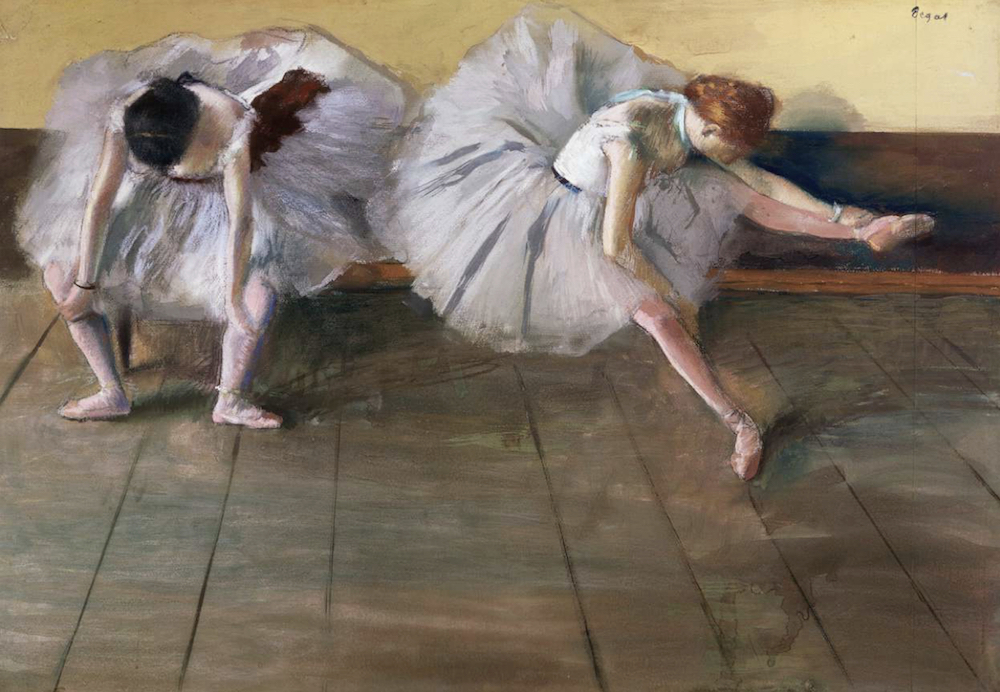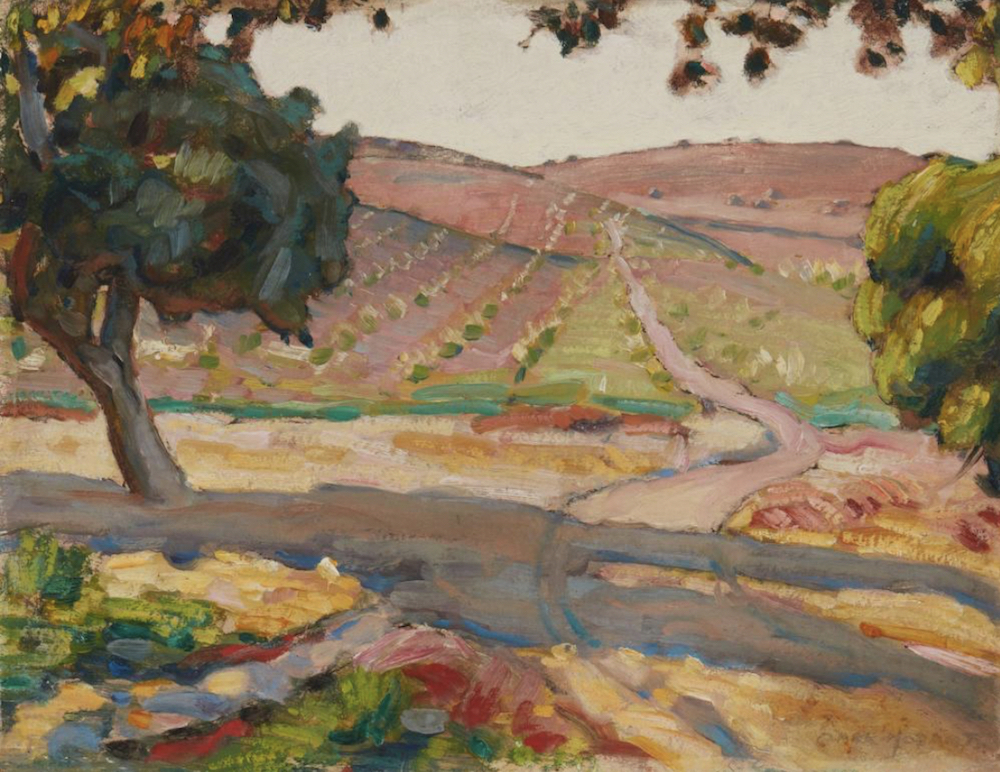II. The Tired Dancer
- Susan Prier
Clark Hobart’s painting The Tired Dancer is one of five works by the American artist owned by Mills College (fig 5). In Hobart’s painting, light from diminished stage lights reflects off a blue costume jacket as well as the dancer’s tutu and legs. The onstage performance is over, but the dancer in this portrait is still performing for the viewer. In the nineteenth century, tutus reverted to knee length from an ankle length dress to show off the dancer’s precise pointe work.1 In this portrait, the dancer is poised, her toes pointed to show off her legs. Her cumbersome velvet skirt draped over the back of the chair allows cooler air to reach her body, bringing her body temperature back to normal. Her heavily made-up face—necessary so she doesn’t project a sallow complexion in the bright on lights on stage—shows the satisfied, if labored, breathing required after an extended period of physical exertion. It may also evince other aspects of life. She is aging and her flexibility and stamina is not what it used to be. She may despair that in her profession being an object of the male gaze is more important than the dignity and reality of a single woman trying to support herself.
 Figure 6
Figure 6Hobart’s The Tired Dancer shares its subject matter with almost fifty percent of Edgar Degas’s oeuvre: the ballet dancer, the dance class, a performance, or after exiting a stage (fig 6). Reminiscent of Degas’s Impressionistic depictions of ballet dancers backstage, Hobart’s work captures both the backstage exhaustion and Degas’s color palette of light pink and pistachio green. Clark studied in Paris from 1900-1903 while Degas was still alive, so it is likely that he saw the artist’s work. After sojourning in New York as the art editor for Burr-Macintosh magazine, and living briefly on the Monterey Coast, Hobart returned to the Bay Area in 1916, and established a practice painting Impressionistic portraits and landscapes (fig 7).
While Degas’s work features rehearsals of the Corp de Ballet of the Paris Opera, including their classes and their backstage lives, Hobart’s painting was created after he returned to the United States. The Tired Dancer, completed in 1920, is likely a portrait of a member of the San Francisco Ballet.
This is a moment of rest before the ballerina takes off her shoes, savoring a memory filled with the just completed dance, knowing it may be the last for this season. A fresh floral bouquet lies at her feet, indicating she may be the prima ballerina. It is customary to throw or give a bouquet of roses or other showy flowers to lead female dancers at curtain calls. Or, as theatre etiquette’s “graveyard bouquet” signals, this may be the last performance of a season or career.2 In either case, the bright light and colors of the dancer’s costume and the fading light from the stage, show the contrast between onstage and offstage life. A poorly hung costume jacket or coat behind the dancer suggests a quick change at some point of the performance, if not for her, for one of her male colleagues. She may be able to slip into it once perspiration cools her body enough for her to shiver in the cold backstage air. The protection its warmth offers to her may not be the protection offered by its owner or the rest of the company. The issues prevalent in the dance world when this portrait was painted have not abated.
The Tired Dancer is an example of the unseen work that women are engaged in behind the scenes. Dancing demands physical endurance as well as emotionally draining artistic expression, sustained by hours and hours of practice. A brief aesthetic performance on stage, interpreting classical choreography for an audience with her bodily actions narrating a story, requires a dancer be in top physical form. Constant physical maintenance of her body and ongoing attendance at auditions may land her a permanent position with an established ballet troupe. If not, she may have to seek other options that compensate her for the minimal wage her uncertain engagements provide.3 A sustained effort goes into taking care of her body, the tool for her profession, but the costs of upkeep can quickly mark her investment’s return red, notes Phoenix Lauren Kay.4 The job description for this profession goes well beyond a dancer’s brief performance on stage. Backstage hours require technique training, as well as auditions, fitness programs, choreography rehearsals and stage and costume fittings before an afternoon matinee and or evening performance. To be successful, a dancer must be highly motivated, exhibiting rhythm, flexibility, persistence and endurance. She often works on this from the time she begins to take lessons in her early childhood.
Despite long hours of practice, a ballerina cannot expect she will have a lucrative career unless she is at the top of her game. A ballet dancer’s salary, like most artists in the performing arts, is minimal. In 2018, Chron.com recorded the median salary for dancers in the United States at $30, 007, with rural areas averaging $20, 604 and better-known urban ballet companies offering $58,723.5 While the median salary of a dancer in the United States is $14.25 an hour, choreographers make almost twice that amount.6 Sexism doesn’t stop there, however. Since its earliest days, ballet has been a woman’s occupation directed by men. Most choreographers are men, who develop their dances to be performed by the younger female body. His vision, expressed by young woman’s bodies, often objectifies, silences and or ignores them. This practice has been criticized most recently by feminist movements such as #metoo. Ellen Whittet O’Connell recently asked, “Is there such a thing as ballet that doesn’t hurt women?” O’Connell’s question instigated an investigation of sexual harassment issues in three prestigious international ballet companies: New York City Ballet, Les Grandes Ballets Canadiens, and Paris Opera Ballet. Alexandria Waterbury, a former ballerina with the New York City Ballet, sued saying the company made it possible for its male dancers to “degrade, demean, dehumanize and sexually abuse women.”7 “Every time I see a little girl in a tutu or with her hair in a bun on her way to ballet class, all I can think is that she should run in the other direction,” Waterbury told The New York Times, “because no one will protect her, like no one protected me.”8
Women’s contributions to ballet have historically been the most ephemeral: They are the archetypal ballerinas, whose careers depend on the constant vanishing point of dancing, over as soon as it happens. The parts of ballet that last past the moment of its occurrence — choreography, teaching, and artistic direction — have long been dominated by men. And this moment, which offers us a chance to have a mainstream conversation about the sexism of ballet, is also an opportunity to seriously consider what ballet’s future might look like. What needs to change to make it less damaging to women, while still preserving its value and beauty? And who needs to be more included in order to effect that change?9
Whittet suggests that the professional dance world think about training and hiring more women in creative and leadership roles. Wendy Whelan, a celebrated former New York City Ballet principle, says that the profession needs to attract people who know the repertory but who will also take the health and safety of female dancers seriously. “To grow so accustomed to privileging how a body looks at the expense of how a body feels, seems like a dangerous game,” says Whelan.10 For a male teacher to put a female student’s leg on his shoulder and then walk forward to see how far she can stretch, seems predatory. It is not about safety, or about correct alignment, it is about the right for male instructors to test the flexibility and limits of the aesthetics of an art form on the canvas of a young woman’s body. This, however, is not the only health issue young ballerinas face. Stress fractures, eating disorders and lower bone mineral density in dancer’s arms are often the result of overtraining. A ballerina’s strength and fortitude, gained through self-disciplined practice, often hides the exploitative, unhealthy, manipulative world of the arts. Here, everyone but the person in the costume benefits from the dancer’s aesthetic talent and practice.
-
“Ballet Costume History,” Tutu Etoile, accessed November 10, 2021, http://tutuetoile.com/ballet-costume-history/. ↩︎
-
Benna Crawford, “Theatre Etiquette and Flowers,” Our Pastimes, accessed November 10, 2021,
https://ourpastimes.com/theater-etiquette-and-flowers-12317797.html. ↩︎ -
Jayne Thompson, “The Salaries of Ballet Dancers,” Chron.com, accessed November 10, 2021, https://work.chron.com/salaries-ballet-dancers-5128.html. ↩︎
-
Phoenix Lauren Kay, “Surviving a Starting Salary,” Dance Magazine, accessed November 10, 2021, https://www.dancemagazine.com/professional-dancer-salary-2306949449.html. ↩︎
-
Thompson. ↩︎
-
How Much Can You Make In Dance? Here Are More Than 200 Actual Salaries,” Dance Magazine, accessed November 10, 2021, https://www.dancemagazine.com/dance-salaries-2587282090.html; and “Occupational Outlook Handbook: Dancers and Choreographers,” U.S. Bureau of Labor Statistics, https://www.bls.gov/ooh/entertainment-and-sports/dancers-and-choreographers.htm. ↩︎
-
Michael Cooper and Robin Pobegrin, “City Ballet and Chase Finlay Sued by Woman Who Says Nude Photos of Her Were Shared,” The New York Times, https://www.nytimes.com/2018/09/05/arts/dance/nyc-ballet-alexandra-waterbury.html. ↩︎
-
Ibid. ↩︎
-
Ellen O’Connell Whittet, “Is There Such A Thing As Ballet That Doesn’t Hurt Women?” BuzzFeedNews, October 18, 2018, https://www.buzzfeednews.com/article/ellenoconnellwhittet/ballet-me-too-nycb-women-gender-injuries-sexism. ↩︎
-
Ibid. ↩︎

